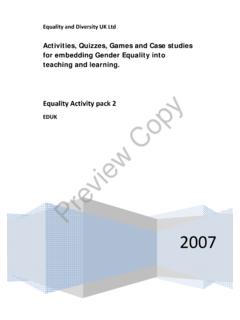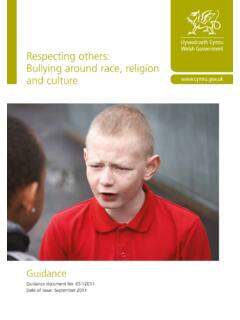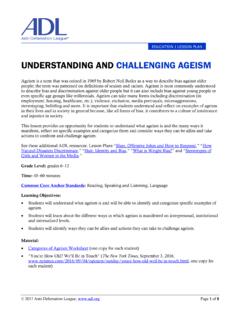Transcription of Loc’d and Faded, Yoga Pants, and Spaghetti Straps ...
1 Jennifer L. Martin, University of Illinois at SpringfieldJennifer N. Brooks, University of Illinois Urbanna ChampaignAbstract This article reviews dress code violations that have made national news in the UnitedStates and globally that spotlight racist and sexist issues embedded in common K 12dress codes. It also analyzes all the school dress codes in one county in a MidwesternAmerican state to examine the associated racist and sexist implications. The articleends with an assessment tool to help readers determine the levels of racism and sex-ism in their own K 12 district dress Some teachers and educational leaders believe that strict dress codes or school uni-form policies can reduce bullying and peer pressure in school (Brunsma, 2004).
2 Somesuggest that uniforms can reduce gang-related activity. Others assert that dress codesare necessary to promote academic success. According to Kira Barrett (2018), someschool officials view dress codes as preparing students for work and adult life. Theytheorize that students who comply with school rules are able to transfer complianceand become successful in other areas of life. Dress codes may have the intention ofpromoting consistent treatment for all, but they are by no means equitable. From theLoc d and Faded, Yoga Pants, and Spaghetti Straps :Discrimination in Dress Codes and School PushoutJennifer L. Martin & Jennifer N.
3 Brooks. (2020). Loc d and Faded, Yoga Pants, and Spaghetti Straps :Discrimination in Dress Codes and School Pushout. International Journal of Education Policy &Leadership 16(19). URL: doi: 16(19)2020 IJEPL is a joint publication of PDK International, the Faculty of Education at Simon Fraser University, theCollege of Education and Human Development at George Mason University, and the University of virtue of their appearance in this open access journal, articles are free to use, with proper attribution, ineducational and other non-commercial settings 90 days after initial publication. Copyright for articles publishedin IJEPL is retained by the authors.
4 More information is available on the IJEPL website: of natural and traditional African and African American hairstyles, as wellas extensions, multicolored cuts, and unique hairstyles, to the policing of female bod-ies, the reality is that dress code violations disproportionately disadvantage minori-tized students, including students of color, LGBTQ+ students, and females. Thisarticle investigates racialized and sexualized content in publicly accessed dress the context of heightened media attention surrounding dress code issues(Pettway, 2017), a qualitative analysis of dress code language was conducted by ex-amining the student handbooks in all the public schools in one county in aMidwestern American state to determine if dress codes are indeed equitable and fairto all students.
5 These student handbooks were publicly available; they were postedonline on school district websites. This analysis revealed racially coded language andsexist and outdated guidelines, raising the question of whether dress codes reallyare intended to promote academic success, or if they exist to maintain hegemonicWhite supremacist and patriarchal norms. This study also sought to determine ifany school dress codes protect human rights, promote equality, and protect self-ex-pression, or if they are mainly a mechanism for hegemonic discipline and preliminary study was inspired by a young adult book by Jennifer Mathieu(2015) called Moxie: A Novel.
6 In the novel, the protagonist, Vivian, and her highschool peers are subjected to dress codes that they perceive to be sexist and otherdifferential expectations based on gender. Vivian finds a collection of her mother sriot grrrl zines in a box labeled My Misspent Youth, and she gets inspired to repli-cate the DIY artistic form in order to assemble like-minded girls and fight the op-pression they face in their ultimately finds like-minded people through creative calls to action. Forexample, Vivian posts flyers around the school seeking solidarity with other girlswho are fed up with what she perceives to be patriarchal differential norms and ex-pectations within the school; she calls them to write stars and hearts on their handswith marker so that they will recognize each other.
7 When the girls join forces, theybegin to engage in collective actions against sexist comments and other more insid-ious problems. For example, they call attention to the bump and grab, a practicewhereby some boys pretend to accidentally bump into a girl and then assault her bygrabbing particular body parts. The girls ultimately stage a walk-out protesting theschool s dress code, because it operate[s] on the idea that boys are helpless creatureswith no self control.. They shame girls! (Mathieu, 2015, p. 109), along with othersexist practices. In the novel, females are held to a higher standard in terms of dresscode expectations, and males are not held accountable for a variety of sexist practices;instead of dealing with issues of sexism within the school culture, the administrationshortsightedly chooses to focus on dress code violations, specifically for the girls effectively blaming the victim in hopes that this will alleviate the 1 is a real-life example of the type of protest in which the characters inthe novel engage.
8 Change does not occur without action, and action does not occurwithout individuals willing to engage in action: activism. At the end of this article, atool is provided to analyze dress codes for unfair expectations based on race andgender (see Appendix). This tool aims to provide aspiring activists with the infor-mation they need to make a difference in the lives of students and in their (19) 2020 Martin & BrooksDiscrimination inDress Codes andSchool Pushout2 Figure 1. A Facebook dress code protestNote:A dress code protest (Fox6news, 2017) Literature review The authors of school dress codes may not overtly aim to be discriminatory.
9 Overall,dress codes provide guidelines for what is acceptable dress in various to Reuben May (2018), Dress codes are legally permissible as long asthey discriminate against only clothing and not against people on the grounds ofrace, color, religion or national origin (p. 48). School dress codes should not beused to directly discriminate on the basis of race or sex, but, often, the rules in placedo appear to target specific students through coded (2018) argues that many school dress codes are written from the defaultperspective of a White male and tend to be more punitive to females and people ofcolor, thus further constraining females of color.
10 Dress code language that policesand sexualizes female bodies is a form of victim blaming, insinuating that certainforms of dress are distractions to learning. Female anatomy including breasts/cleavage and girls backs, shoulders, and legs (these examples are considered sexuallyattractive/provocative in the in the current milieu (Pettway, 2017) is the focusof many school dress codes. Moreover, the current state of public school dress codesdoes little to protect female students; it targets them through to Rouhollah Aghaseleh (2018), the use of school dress codes teaches stu-dents which bodies matter and which do not.)
















